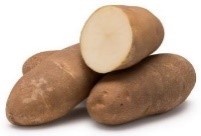Teton Russet Fact Sheet

| Teton Russet (A0008-1TE) |
 |
Parentage – Blazer Russet x Classic Russet1,2,3
Breeder – Originated from a hybridization at the USDA Agricultural Research Service, Aberdeen, Idaho in 20001,2; released for production by the Pacific Northwest Potato Variety Development Program (comprised of the USDA Agricultural Research Service and the Agricultural Experiment Stations of Idaho, Oregon and Washington) in 20111,4
Maturity – Early-season1,2,3,4
Usage – Primarily grown for fresh market and processing; excellent fry color1,2,3,4
Plant –Small-medium, partially compact bush, semi-erect structure; stems with weakly prominent stem wings and strong anthocyanin pigmentated coloration in lower half1
Leaves –Large, partially closed, moderate pubescence1; dark green with weakly wavy margins; weak anthocyanin pigmentation on the upper side of the leaf midrib (main vein) and petioles; terminal leaflets are broadly ovate with a tapered tip and obtuse base; two to five pairs (average of 3.5) of medium ovate, tapered tip primary leaflets with heart-shaped bases; six to ten pairs of (average of 6.7) secondary and tertiary leaflets1
Flowers – semi-star shape, medium size, white with yellowish-orange loose shaped anthers; limited pollen production; limited frequency of flower clusters (one to five) per plant1
Tubers – Oblong to long, medium reddish-brown, russet skinned1,2,3; average of fourteen evenly distributed, shallow eyes with medium prominent eyebrows per tuber; white flesh; sprouts have a blue-violet pigmentation at base and tip; approximately five to six tubers produced per plant1; medium-high specific gravity; medium dormancy period1,3
Strengths – High US # 1 yields with high vitamin C and protein content; resistant to common scab and Fusarium Dry Rot; moderately resistant to net necrosis1,3,4; low incidence of growth cracks and secondary growth1,3; tolerant of Metribuzin3
Weaknesses – Susceptible to Verticillium wilt, black dot, Columbia root- knot nematode, early blight, late blight, corky ringspot, potato leafroll virus, soft rot, potato virus X and Y1 and shatter bruise1,3
References: 1Novy, R. G. et al. 2014. Teton Russet: An Early-Maturing, Dual-Purpose Potato Cultivar Having Higher Protein and Vitamin C Content, Low Asparagine, and Resistances to Common Scab and Fusarium Dry Rot. American Journal of Potato Research. 91:380–393. 2http://www.inspection.gc.ca/english/plaveg/pbrpov/cropreport/pot/app00009068e.shtml 3http://www.pvmi.org/storage/General/Teton%20Russet%20Flyer%202011%209%20v2.pdf 4Brandt, T. et al. 2015. Storage Management of Teton Russet Potatoes. University of Idaho Extension.
Page 1 of 1
Last Revised: 4/11/2019
© 2017 The Board of Regents of the University of Wisconsin System
This article was posted in Fact Sheet.

